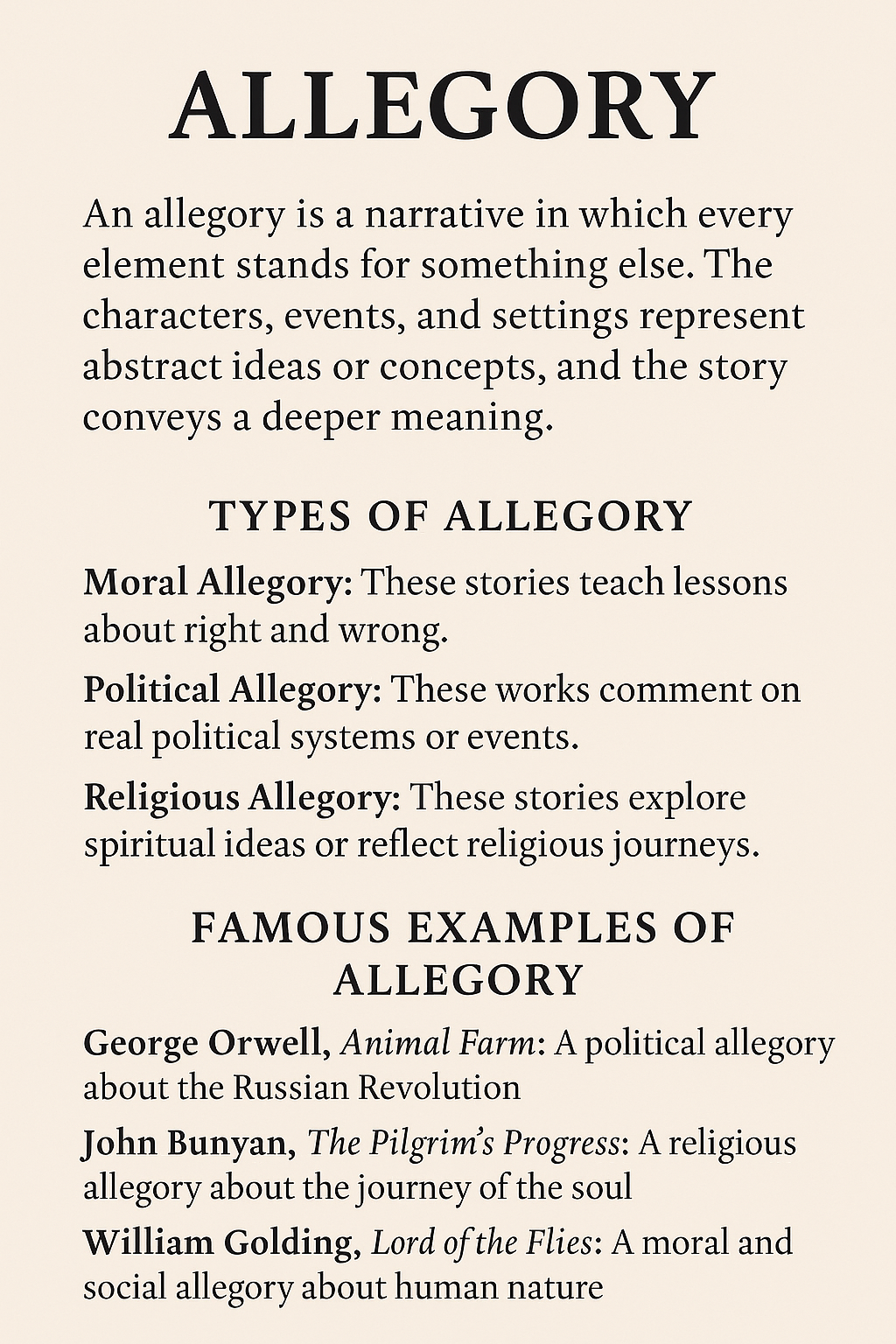Allegory in Literature: A Story Beneath the Story
Allegory is one of the most powerful tools in literature. It allows writers to say something important without stating it directly. Through characters, settings, and plots, authors can express deep moral, political, or spiritual truths. An allegory may look like a simple story, but beneath the surface, it carries a much greater message.
What Is Allegory?
In simple terms, an allegory is a narrative in which every element stands for something else. The characters, events, places, and objects in an allegory all represent abstract ideas or principles. Often, allegories teach lessons or express criticism. They may speak about good and evil, freedom and control, or the journey of the soul.
Unlike symbolism, where a single object may have multiple meanings, allegory works through structure. Everything in the story has a planned role. As a result, allegories usually have a clear, fixed interpretation.
Types of Allegory
There are many kinds of allegories, depending on what they aim to teach or represent.
- Moral Allegory: These stories teach lessons about right and wrong. Characters may represent virtues like honesty or sins like greed.
- Political Allegory: These works comment on real political systems, leaders, or events. They criticize or support ideologies using fictional characters.
- Religious Allegory: These stories explore spiritual ideas or reflect religious journeys. They often use biblical or sacred symbols.
No matter the type, all allegories use storytelling to deliver a message beyond the surface plot.
Famous Examples of Allegory
One of the most well-known allegories is George Orwell’s Animal Farm. On the surface, it tells the story of animals rebelling against their human owner. But in truth, it is about the Russian Revolution. Each animal represents a real person or group in Soviet history. Napoleon the pig stands for Joseph Stalin, while Boxer the horse symbolizes the working class.
Another classic example is John Bunyan’s The Pilgrim’s Progress. In this religious allegory, the character “Christian” journeys from the City of Destruction to the Celestial City. Every location and person along the way represents a spiritual challenge or truth.
Even William Golding’s Lord of the Flies contains allegorical elements. The boys on the island can be seen as symbols of different parts of society, such as law, chaos, and morality.
Why Writers Use It
Writers often use allegory to speak safely about dangerous topics. For example, in times of political repression, a writer might criticize a leader through an animal character. Allegories also help readers think more deeply. Instead of just reading a story, readers must interpret it.
Moreover, allegories have lasting power. Because they express universal truths, they stay relevant long after their time. They invite reflection and discussion, encouraging readers to explore meaning beyond words.
Final Thoughts
Allegory is much more than a storytelling device. It is a way to speak the truth in disguise. Through symbolic characters and events, it reveals the deeper struggles of humanity. When readers learn to recognize it, they gain a new level of understanding and appreciation for literature.

Jack London and Naturalism: https://americanlit.englishlitnotes.com/jack-london-and-naturalism/
Expressions of Time, Money and Distance in English Grammar:
https://grammarpuzzlesolved.englishlitnotes.com/expressions-of-time-money-distance/
The King and the Spider: https://englishwithnaeemullahbutt.com/2025/05/10/the-king-and-the-spider/
Personification in Poetry: Definition and Examples: https://englishlitnotes.com/2025/06/18/personification-in-poetry/
Discover more from Naeem Ullah Butt - Mr.Blogger
Subscribe to get the latest posts sent to your email.
